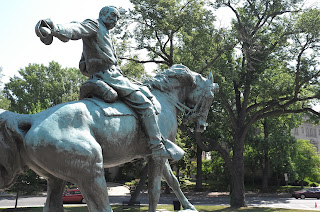Across the United States, Irish immigrants named towns Emmetsville (Fl., Tx.), Emmetsburg (Md., Ia.) and Emmetstown (Oh., Mn.), to name a few. Statues commemorating his martyrdom abound.
But on Embassy Row in Washington, DC, Robert Emmet remains in the dark.
What may be the best statue of Emmet giving his famous speech is barely visible - even after the National Park Service (NPS) turned on the lights in a park that features the statue at Mass Ave, 24th and S Streets NW.
 |
| Spot the statue? Statue of Robert Emmet seen from Mass Ave at 5:30 pm on December 30. |
NPS took the tree down in time for a centennial celebration of the 1916 Easter Uprising, held at the park in April 2016.
Still - no lights! We reminded the NPS and Smithsonian American Art Museum which owns the statue.
Cheerful NPS workers activated the lights in September, in time for another ceremony featuring an address by new Irish Ambassador Daniel Mulhall. Still, per our December 30 photo taken at 5:30 pm, travelers can barely discern the statue - and miss a great moment.
The nation's capital needs this inspiring public art to be accessible and admired. Otherwise our Grand Avenue falls short of its purpose as an inspiring civic space.
 |
| Daniel Mulhall, Ambassador of Ireland, speaks at Emmet Park. Photos: RMA |













